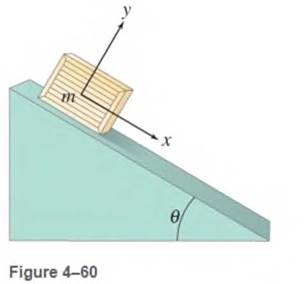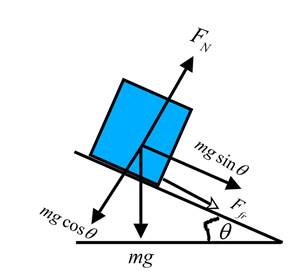
Concept explainers
A crate is given an initial speed of 3.0 m/s up the 25.0° plane shown in Fig. 4-60. (a) How far up the plane will it go? (b) How much time elapses before it returns to its starting point? Assume

Part(a)
The distance the block would go up an inclined plane when given an initial velocity.
Answer to Problem 58P
Solution:
The distance the block goes up the block is 0.29 m.
Explanation of Solution
Given:
The initial speed of the block
The angle of the incline
The speed of the block at the distance s is
Formula used:
A block is given an initial speed. Itslides up a distance s along the length of the incline which is at an angle
The free body diagram for the block is shown in the diagram below.

The weight mg of the crate acts vertically downwards. The normal force
Since there is no motion perpendicular to the incline,
The force of kinetic friction is related to the normal force as,
Since the crate slides up the incline, there is a net force F that acts downwards. This is given by,
Substitute equations (1) and (2) in (3).
From Newton’s second law,
Here, a is the resultant acceleration of the crate down the incline.
Therefore,
The distance s it travels up the slope is calculated using the equation,
Calculation:
Calculate the acceleration of the crate by substituting 9.8 m/s2for g and the given values for
Since the acceleration acts opposite to the direction of motion of the crate, a negative sign is affixed to the acceleration.
Calculate the distance the crate travels up the incline using the expression
Conclusion:
The motion of a block sliding up the inclined plane is analyzed by constructing its free body diagram. The acceleration of the block is determined using the free body diagram and Newton’s second law. Using the equations of motion, the distance the block slides up the plane is found to be 0.29m.
Part(b)
The time taken by the block t returns to the starting point.
Answer to Problem 58P
Solution:
The time taken by the block to return to the starting point is 1.2 s.
Explanation of Solution
Given:
The initial speed of the block
The angle of the incline
The speed of the block at the distance s is
Formula used:
The time taken by the crate to return to its starting point can be calculated using the third equation of motion.
Where,
Calculation:
When the block reaches the starting point, its net displacement snet is zero. Use 0 for s and the given values of v,
The equation has two roots,
Since
Conclusion:
The motion of a block sliding upthe inclined plane is analyzed by constructing its free body diagram. The acceleration of the block is determined using the free body diagram and Newton’s second law. Using the equations of motion, the time taken by the block to reach the starting point is found to be1.2 s.
Chapter 4 Solutions
Physics: Principles with Applications
Additional Science Textbook Solutions
Biology: Life on Earth with Physiology (11th Edition)
Cosmic Perspective Fundamentals
Genetic Analysis: An Integrated Approach (3rd Edition)
Microbiology with Diseases by Body System (5th Edition)
Anatomy & Physiology (6th Edition)
Human Physiology: An Integrated Approach (8th Edition)
- Consider a rubber rod that has been rubbed with fur to give the rod a net negative charge, and a glass rod that has been rubbed with silk to give it a net positive charge. After being charged by contact by the fur and silk...? a. Both rods have less mass b. the rubber rod has more mass and the glass rod has less mass c. both rods have more mass d. the masses of both rods are unchanged e. the rubber rod has less mass and the glass rod has mroe massarrow_forward8) 9)arrow_forward10) 11) 12) 13) 14) 15)arrow_forward
- Mick and Rick are twins born on Earth in the year 2175. Rick grows up to be an Earth-bound robotics technician while Mick becomes an intergalactic astronaut. Mick leaves the Earth on his first space mission in the year 2200 and travels, according to his clock, for 10 years at a speed of 0.75c. Unfortunately, at this point in his journey, the structure of his ship undergoes mechanical breakdown and the ship explodes. How old is Rick when his brother dies?arrow_forwardHi, I have canceled, why did you charge me again?arrow_forwardNo chatgpt pls will upvotearrow_forward
 College PhysicsPhysicsISBN:9781305952300Author:Raymond A. Serway, Chris VuillePublisher:Cengage Learning
College PhysicsPhysicsISBN:9781305952300Author:Raymond A. Serway, Chris VuillePublisher:Cengage Learning University Physics (14th Edition)PhysicsISBN:9780133969290Author:Hugh D. Young, Roger A. FreedmanPublisher:PEARSON
University Physics (14th Edition)PhysicsISBN:9780133969290Author:Hugh D. Young, Roger A. FreedmanPublisher:PEARSON Introduction To Quantum MechanicsPhysicsISBN:9781107189638Author:Griffiths, David J., Schroeter, Darrell F.Publisher:Cambridge University Press
Introduction To Quantum MechanicsPhysicsISBN:9781107189638Author:Griffiths, David J., Schroeter, Darrell F.Publisher:Cambridge University Press Physics for Scientists and EngineersPhysicsISBN:9781337553278Author:Raymond A. Serway, John W. JewettPublisher:Cengage Learning
Physics for Scientists and EngineersPhysicsISBN:9781337553278Author:Raymond A. Serway, John W. JewettPublisher:Cengage Learning Lecture- Tutorials for Introductory AstronomyPhysicsISBN:9780321820464Author:Edward E. Prather, Tim P. Slater, Jeff P. Adams, Gina BrissendenPublisher:Addison-Wesley
Lecture- Tutorials for Introductory AstronomyPhysicsISBN:9780321820464Author:Edward E. Prather, Tim P. Slater, Jeff P. Adams, Gina BrissendenPublisher:Addison-Wesley College Physics: A Strategic Approach (4th Editio...PhysicsISBN:9780134609034Author:Randall D. Knight (Professor Emeritus), Brian Jones, Stuart FieldPublisher:PEARSON
College Physics: A Strategic Approach (4th Editio...PhysicsISBN:9780134609034Author:Randall D. Knight (Professor Emeritus), Brian Jones, Stuart FieldPublisher:PEARSON





